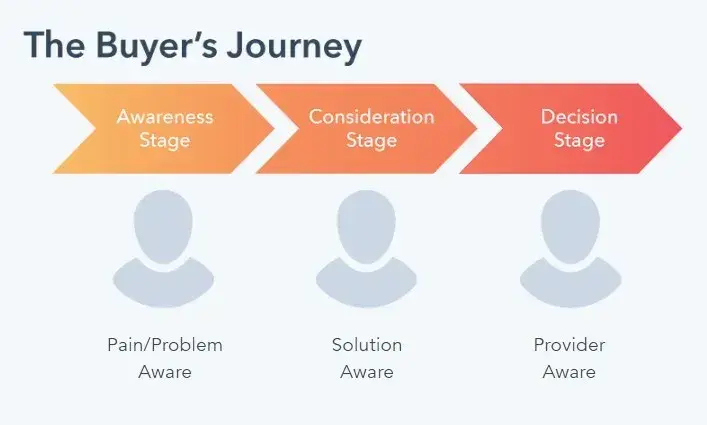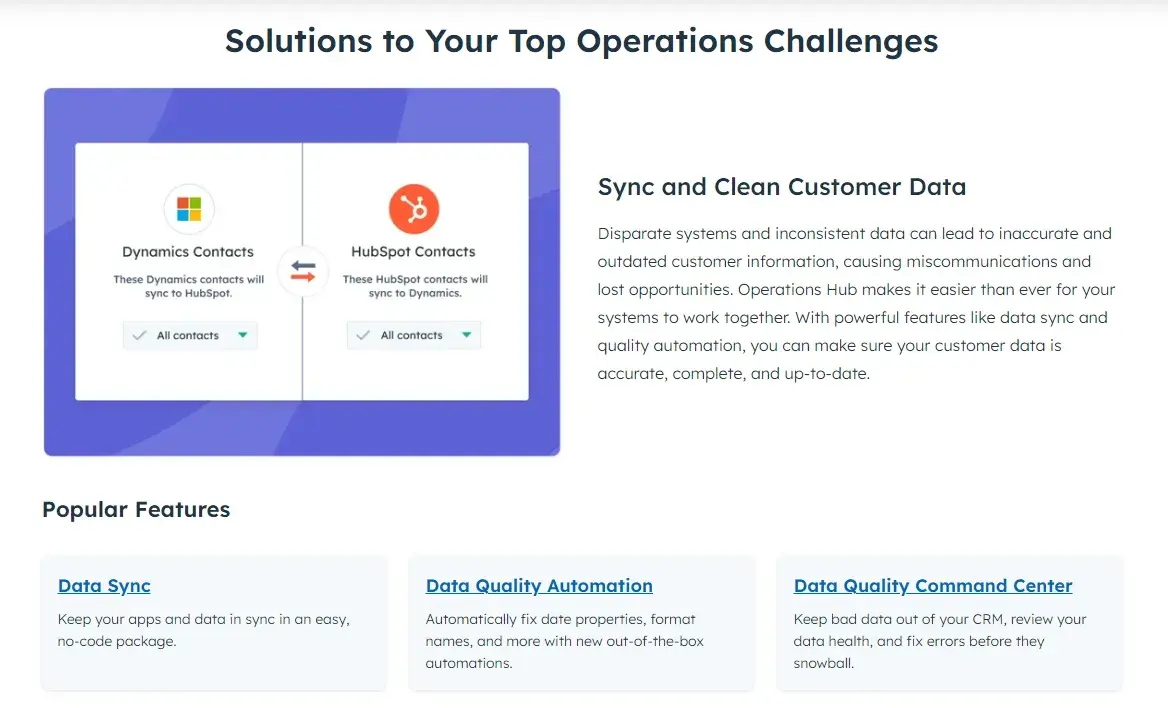The TL-DR of it is: Data silos are a big blocker for decision-making, which ends up getting in the way of your business growth. Knowing exactly what they are, how they affect your team, and how to solve them makes all the difference.
Table of Contents
- What Is a Data Silo?
- Causes of Data Silos
- Why Are Data Silos Problematic?
- How to Identify Data Silos
- Solutions for Getting Rid of Data Silos
- Preventing Data Silos
What Is a Data Silo?
A data silo is a group of raw data that is accessible by one department but isolated from the rest of that organization. This results in a severe lack of transparency, efficiency, and trust within that organization.
This usually happens because the data is collected by a business tool that is isolated from the rest of your technology ecosystem.
Data silos are common in larger companies because separate teams and departments naturally have their own goals and priorities and often operate separately. But having worked for large government organizations and smaller privately owned businesses, I know from experience: Data silos can happen to any organization of any size.
Causes of Data Silos
When I was an admin, nothing was more frustrating than being unable to access data from other teams — especially when it came to answering customer phone queries. Instead of putting customers on hold while I found the answer from another department, it would’ve been so much easier to have one source of data truth across relevant teams.
Here are some common causes of data silos among organizations:
1. Issues With Technology
Data cannot easily pass between departments of organizations that don't have access to proper technology. Companies need to own high-quality applications that can handle quick transfers of information and cross-references. Also, some teams may be better trained in using the technology for data transfer than other teams, which could lead to problems in the latter being able to access the same information.
Expert Insight
Ben Vaughan, who is the vice president of analytics services at Brewster Consulting, shares another way that technology issues may cause data silos. Aside from not having the right tech in place, silos can arise because of making fast-paced investments in new technology.
“We help small to medium-sized businesses with data management and analytics, and so Data Silos are a very common occurrence with our clients,” Vaughan explains.
Vaughan notes that it‘s very common in fast-paced organizations to make quick decisions about adding new technologies when an existing one isn’t perfect.
“Leaders are forced to make investments in new technologies instead of fixing the problems with existing ones. This will quickly generate data silos and redundancies that should be cleaned up over time,” Vaughan says.
2. Growth in Organizations
Sometimes, when an organization grows too large, it becomes difficult to pass data easily. There may be far too many departments, offices throughout the nation or world, or employees, resulting in isolation from the rest of the company. Also, when organizations become too large too fast, there may be structural issues. It may require several steps for data to be passed down the hierarchy.
Example
Helix Sleep Co-Founder Adam Tishman, discusses the challenges data silos pose for a rapidly growing startup.
“In the direct-to-consumer space, data is everything,” says Tishman. “But early on, we found ourselves grappling with data silos that hindered our ability to efficiently use the data we were collecting. The main issue we faced was that our growth outpaced our tech stack, leading to unintentional data compartmentalization.”
Tishman cites marketing data, product feedback, and operational data housed in different tools and platforms as examples of this data compartmentalization.
Tishman adds, “As a rapidly growing startup, this problem is common when you add new software solutions to solve immediate needs but don't integrate them effectively across teams.”
3. Decentralized IT Services
Sometimes, organizations will have decentralized IT services, allowing departments to buy their own software and technologies. This leads to databases, platforms, and other incompatible applications connected to other systems within the organization. When IT purchases are isolated within departments or teams without checking for compatibility with existing systems, data silos can be created unintentionally.
Expert Insight
Ben Vaughan shares this concern. “When the IT function or the CTO/Technology team is not actively engaged with all business units, it removes a key check and balance from new technology purchases,” says Vaughan.
Vaughan notes that isolated business units rarely consider the tech other business units use before making investments. “As such, no one can suggest using existing technologies instead of purchasing a new one. That, in turn, causes silos,” Vaughan says.
Why Are Data Silos Problematic?
When I worked in sales, trying to manage the pipeline without access to customer success data was a constant struggle. Is that customer ready for an upsell? Are they happy? Have they churned? Who knows!
Whatever the cause may be for your organization, it‘s clear that data silos aren’t good — here’s exactly why.
1. They give an incomplete view of the business.
C-level executives have the task of consolidating all the company's data. If you are that executive making the calls, you know your sales teams will talk about new clients, marketing will share the number of leads and traffic, and the accounting team can report expenses and profit. But what links all that information together?
Trying to manage a business with isolated data is like putting together a jigsaw puzzle without the picture on the box. Data silos stop you from having a 360-degree view of your business.
Expert Insight
Previn Pillay, CEO of Pyromin Consulting, an industrial consultancy for operational excellence and technical due diligence, agrees.
“We use technology to streamline operations, but we also address the deeper challenges — like data silos — that slow businesses down and block efficiency,” says Pillay. According to Pillay, data silos lead to miscommunication and inefficiency.
He adds, “When departments can’t share critical information, they end up working with incomplete data, which is a serious problem for operations. It drags down productivity, and no one gets the full picture. It also makes cross-team collaboration harder, and that’s a huge issue — especially in industries like mining.”
2. They create a less collaborative environment.
I’ve found each team ends up working independently in the presence of data silos. They only have access to their own data, so that is the only data they work with. This creates a divided organization. Teams do not collaborate with each other on projects, which makes it nearly impossible for the company to share a common vision.
I've said that managers want to make decisions based on data. However, if the leaders of each team can’t see the big picture and only have access to their own fragment of the data, their individual decisions will rarely be aligned with global business goals.
In environments where data silos are the norm, a culture of transparency and trust is very difficult to maintain. Instead, you might be creating rivalry and competition between teams focusing on their own micro-goals.
Expert Insight
Rob Stevenson, seasoned tech expert and founder of BackupLabs, specializes in identifying and solving data management challenges within organizations. Stevenson has seen firsthand how data silos impact collaboration.
“Data silos are detrimental because they limit visibility and hinder effective decision-making,” says Stevenson. “When data is scattered across various systems, it creates barriers to collaboration, often resulting in teams duplicating efforts or working with different information sets. This not only confuses employees but also slows down processes and increases the risk of errors.”
He adds, “I’ve seen cases where poor data sharing has led to missed opportunities, especially in customer engagement. Ultimately, the inefficiency and inconsistency that silos create can damage an organization’s credibility and operational efficiency.”
3. They lead to poor customer experience.
In most businesses, there are multiple customer touchpoints. These interactions happen through a variety of channels and during different stages of the buyer's journey. That means that you'll have members of several teams like support, billing, sales, or marketing interacting with the same customer or buyer.

When data is isolated, you can easily lose track of your customer's story with your company. And nothing is more frustrating for a customer than having to repeat their story over and over again to different people.
The real kicker? Poor customer experience can cost your business more than you might think. Zendesk’s CX Trends Report finds that 60% of consumers have purchased something from one brand over another based on the service they expect to receive. It’s no wonder, then, that Gartner data shows that over 80% of organizations expect to compete mainly based on CX.
Expert Insight
According to David Li, the owner of MV Coin Shop and a Harvard Computer Science graduate, poor CX caused by data silos can hurt your credibility. “Data silos are more than operational inefficiencies; they directly affect your brand,” Li explains. “We learned this the hard way when we lost a high-value customer due to slow communication between departments.”
He adds, “In the rare coin business, precision and trust are everything. A few hours' delay in appraising or confirming availability can cost you a lot. Silos make your business sluggish, and customers sense it, eroding their trust.”
4. They slow the pace of your organization.
It‘s a waste of time to have data silos. Rather than being able to automatically streamline data across teams, data is isolated within teams. This means teams have to wait until they realize they need data they don’t have, find where the data lies within the organization, manually gain access to it, and then analyze it for their own purposes. By the time you collect the data, it may no longer be valid.
Expert Insight
Computer Science Expert David Li returns to share his experience as a business owner navigating a plethora of data. In Li’s experience, decentralized systems breed disconnection in a growing business, and disconnection slows growth.
“As we expanded, we fell into the trap of using multiple niche tools for different operations, one for ecommerce, another for inventory, and another for appraisals,” says Li. “Each department chose tools that suited their needs, but none of these systems were talking to each other.”
Li emphasizes that growth naturally brings complexity.
“When IT is decentralized, that complexity turns into operational chaos. The silos became glaringly obvious when our sales team didn't have access to the latest inventory figures, causing delays and errors during high-stakes coin auctions,” Li says.
5. They create a security risk.
If employees are storing spreadsheets, documents, and other data on their individual devices, it increases the security risk for the company if proper security controls are not in place. I think data silos also make it difficult to comply with data privacy laws since it’s complicated to track down who has access to what.
6. They waste storage space.
If every single employee who needs the same data saves it to their company storage folder, that wastes precious storage space. This, in return, wastes your budget on storing data that you neither need nor want. It would consume a lot less space if the data were streamlined onto one platform that was accessible by all employees within that organization.
7. They threaten the accuracy of your data.
Data is one of the most valuable assets of your business. Having several tools to collect information about your prospects, customers, and partners increases your company's value. But when that data is outdated, incomplete, or missing, the value that you could get from it goes down significantly.
As I mentioned above, the longer the isolated data sits around, the more likely that it becomes outdated and, thus, inaccurate and unusable. In addition, every team may have access to their own set of the same data. This leads to data that skews in favor of the team that owns them.
Working with data silos results in poor-quality data because these fragmented pieces of information are difficult to assemble. If your data is not integrated or in sync, you'll surely see conflicting data when you try to cross-check the information from different sources.
Expert Insight
According to Ben Vaughan, data silos limit growth opportunities in organizations by limiting the potential of a key data finding. “If department X has data in their siloed data system that would be insightful for department Y, but department Y has no idea that that data exists, the organization suffers from the missed opportunity to improve using their data.”
How to Identify Data Silos
In order to remedy data silos, you first have to be able to find them. However, since teams can function as autonomous units within the company, data silos can be difficult to detect.
Some signs I’ve found that can point you in the right direction are:
- Complaints about lack of data for specified business initiatives.
- Impossible to find data illustrating a big-picture view of the business.
- Departments report inconsistent data and errors that go uncorrected.
- Unsure of the metrics your teams are using.
- Inability to access data quickly.
It's tedious work, but ideally, your IT department would be able to help you get started with a list of systems in use at your company and who uses them.
Still need more inspiration? No worries, here’s how the experts I spoke to identify data silos.
1. Customer Experience Failures
Earlier, I shared some stats from Zendesk and Gartner highlighting just how important good CX is… that is, if you want your ideal customer to choose you over your competition. Want to improve your customer experience? Turn to your CX data to identify data silos.
“At MV Coin Shop, we didn't recognize our data silos until we started losing sales leads,” says business owner David Li. “Customers would request an appraisal on a rare coin, but their inquiry would get stuck between our website and the sales team.”
Li explains that it wasn’t until collectors complained about slow responses that the team realized different departments operated on separate data systems.
“The most telling sign was the lack of visibility across teams. When one part of the company is completely unaware of what another department is doing, you've got a data silo issue,” says Li.
2. Restricted User Permissions
“Restricted user permissions are one of the biggest signs,” says Previn Pillay. “When people can’t access the data they need, it’s clear something’s wrong. Data silos often exist because different departments don’t share systems. If you notice that information isn’t flowing across teams, you likely have silos blocking access.”
3. Discrepancies in How Teams Access and Use Data
Rob Stevenson recommends the following, “Identifying data silos needs a keen eye for discrepancies in how teams access and use data. I often start by looking at workflows, and if teams are using different databases or tools without a clear link between them, that's a red flag.”
Pro tip: Stevenson suggests holding regular feedback sessions, which can reveal if employees feel they lack access to necessary data.
“Furthermore, if you see that certain projects or decisions seem to rely on incomplete or outdated information, that could be an indication that silos are at play. Conducting anonymous surveys can also help reveal frustrations related to data accessibility,” Stevenson says.
Solutions for Getting Rid of Data Silos
Since data silos happen when you have different databases isolated from one another, a lot of managers think it's simply about importing and exporting those databases. But, I’ve found that the problem is that data is not static. Phone numbers and emails change, people leave companies, and prospects become customers or even providers.
Because data is constantly changing, no matter how often you import/export CSV files, the information will never be fully up-to-date. It would take dozens of manual import/export operations each month, which would take a huge amount of time and heighten the risk of manual data entry errors.
Luckily, there are better options to prevent and solve data silos.
1. Use integration software.
Your data is most likely located within different pieces of software. Integrating those systems correctly is the most effective way to avoid data silos. For the users of cloud-based applications, Integration Platforms as a Service (iPaaS) are an outstanding solution.
Among the best iPaaS solutions, you'll find HubSpot’s Operations Hub with two-way customer data sync, Zapier for one-way data pushes, and Mulesoft for enterprise solutions.

Integration software solves all the problems I explored above. You'll have high-quality data that will give you a complete picture of your customer. In addition, it ensures that your data is automatically updated and helps your different teams get on the same page, resulting in a better customer experience.
2. Choose an all-in-one solution to unify your data management.
2024 research from Informatica shows that 38% of data leaders find the increasing volume and variety of data a significant technical obstacle in their data strategy. Meanwhile, issues with data fragmentation and complexity are expected to increase.
Given this, it’s no wonder that 100% of data chiefs “plan to specifically invest in data management capabilities.” But what might this investment look like in practice?
All-in-one solutions can also be referred to as platforms. These are software providers that offer different products to cover several business processes. When your sales, marketing, and customer support teams work with the same provider, it’s easier to avoid data silos.
I think using platforms is a great way to keep teams aligned. When some of the software solutions you use come from the same brand, they'll probably use the same terms to talk about the different types of data, making communication between teams smoother. It also makes it easier for them to share customer and contact data without manual labor or third-party tools.
The most important step is to find the right platform for your company on which you can streamline all your data. That means no more loose Excel spreadsheets and random software shared only by individual teams. Consolidating all data onto one platform will make it easier to share that data between departments. You won't have to dig through your own private records upon request; everything will be accessible to everyone.
If you already use one of these platforms, you’re on the right path. Just keep in mind that as your business grows, you might need to add more business applications to your software stack. And not all of them will come from the same software vendor. That’s when you can start looking for the best software integration solutions for your business.
Example
According to Adam Tishman, the company solved its data silo issues by investing in centralized data infrastructure.
“We implemented a data warehouse to collect and integrate data from all departments, allowing for a 360-degree view of each customer,” says Tishman. “This change significantly improved our ability to make data-driven decisions, reduced time to action, and enhanced the personalization that our customers value.”
3. Search for applications with native integrations.
This one is tricky. For companies that develop business applications, creating in-app or native integrations between systems is complex at a technical level. Even with open APIs, there‘s a lot of time and effort involved. Also, with so many applications out there, it’s impossible to build a native integration for every tool you are using next to their app.
Be that as it may, some applications detect popular use cases and create tailored solutions to connect their data with another app. It’s common to see native integrations between CRM and marketing tools, accounting and billing software, and ecommerce and billing apps, among others.
4. Create a more collaborative company culture.
It's important for the executives of a company to create an organization that embraces company culture. At HubSpot, we have a diversity and inclusion team that works hard to create a culture that brings together all employees, no matter if they work in Cambridge or Dublin or are interns or C-level executives.
Planning company-wide events, creating a Culture Code like ours, and, overall, making each employee feel valued can create a company that’s more accepting of one another and collaborative. This makes it much easier for employees to want to share data with people outside of their teams.
Example
“I've encountered the challenge of data silos, particularly when integrating data from different departments for our marketing analytics,” says Deep Cognition Vice President of Sales and Marketing John Pennypacker. “One unconventional approach we took to address this was implementing a ‘Buddy System’ every month.”
Pennypacker explains that on these days, Deep Cognition pairs team members from different departments to investigate and map out data flows across the company.
“We once paired a marketing analyst with someone from finance. They discovered that customer lifetime value calculations needed to be more consistent between departments due to different data sources being used. This cross-departmental collaboration not only helped us identify and break down data silos but also improved overall data literacy across the company.”
The takeaway? Addressing data silos isn‘t just about technology — it’s about fostering a culture of data sharing and collaboration.
“By making it a regular, engaging activity, we've turned what could be a dry, technical task into an opportunity for team building and knowledge sharing. Sometimes, the best solutions to technical problems come from encouraging human interaction and understanding,” Pennypacker says.
5. Take the time to sort through outdated data.
I know it can seem very daunting to go through what may be years and years of outdated, isolated data. However, in order to create a data management system that is actually usable, you want to ensure that all the data in it is current and accurate. So, have your company slowly work through all the data stored and weed out anything unnecessary. This can double as a team-building activity — it's a win-win.
6. Take a multi-pronged approach.
To tackle data silos effectively, Stevenson advocates for a multi-pronged approach. This approach includes:
- Implementing a centralized data strategy so that all teams have access to the same information.
- Using API integrations to facilitate seamless data sharing between systems, reducing redundancy.
- Establishing a regular review process for data sources to help identify and eliminate silos before they become problematic.
- Training employees on data literacy to promote a culture where sharing and collaboration are prioritized.
He adds, “Lastly, I find that having data stewards in each department can help ensure that data is managed properly across the organization, making it easier to maintain data integrity and accessibility.”
7. Establish a centralized data governance framework.
Previn Pillay recommends establishing a centralized data governance framework as an essential way to standardize access. “By setting clear guidelines for how data is managed and shared, you can eliminate those barriers between teams,” says Pillay.
“Everyone needs to be on the same page — having a central framework ensures that,” Pillay explains. “This kind of structure helps you prevent silos from forming and makes sure data is accessible across the board.”
Preventing Data Silos
In my experience, data silos affect a business’ team, customers, the value of data, and the company vision. Plus, as a data user in any business, having to jump through multiple departments, teams, and stakeholders to find what you need can be a real headache. Fortunately, there are ways to use technology to prevent that.
Integrating your different business applications is your best bet to avoid data silos. The solution you need might already be available inside the business applications you’re using as native or in-app integrations. If not, there are iPaaS solutions waiting for you.
Still, whatever approach you take to solving data silos, I cannot emphasize enough how important it is to standardize data governance across your organization. Not only will this increase data literacy, it will make sure everyone in your organization knows how to access data without impacting data privacy or causing security risks.
This article was originally posted in May 2020 and has been updated for comprehensiveness.

.jpg)


![Customer Data Integration: A Complete Guide [Expert Tips & Examples]](https://53.fs1.hubspotusercontent-na1.net/hubfs/53/customer-data-integration-1-20241218-9529716.webp)






![What Is an Identity Graph? [The Plain-English Guide]](https://53.fs1.hubspotusercontent-na1.net/hubfs/53/identity-graphs.jpg)
